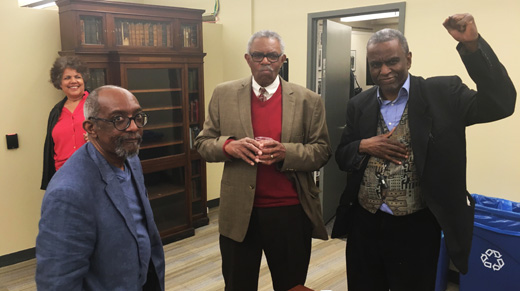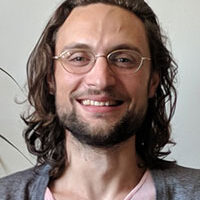
May Day 2016 visited the United States amid the charged atmosphere of a nation undergoing rapid changes. The new Civil Rights Movement as expressed by the #BlackLivesMatter movement and movements for immigration justice continue to make their demands, and increasingly are uniting with workers’ struggles, such as the #Fightfor15 and a Union. Verizon workers celebrated International Workers Day by entering their third week on the picket line.
A public forum was held on April 29-30 of May Day weekend to uncover the buried history of communists’ role in the Civil Rights Movement of the 1950s and ’60s. This forum was held at New York University’s Tamiment Library, which houses one of the oldest collections on the history of radical organizing in the U.S.
The forum brought together experts and activists, including: Gerald Horne, John J. and Rebecca Moores Chair of History and African American Studies at the University of Houston; Gene Tournour and Marian Gordon, both members of the Congress of Racial Equality (CORE); Jarvis Tyner, former Executive Vice Chair of the Communist Party USA through 2014; Ian Rocksborough-Smith, teaching faculty at St. Francis Xavier University; and LaShawn D. Harris, teaching faculty at Michigan State University. Timothy V. Johnson, director of the Tamiment Library, and Sara Haviland, faculty member at St. Francis College, led the Saturday morning and afternoon panels, respectively.
Gerald Horne opened the event Friday evening with a presentation on his book, Paul Robeson: The Artist as Revolutionary. In this talk he discussed Robeson’s brilliance as an artist, as a linguist, and as a political economist. He spoke of his dedication to the struggle in the Civil Rights Movement and of the internationalist character of his vision.
Gene Tournour opened up Saturday morning’s panel speaking about his experiences with the FBI. He recalled being taken for a drive by FBI agents who questioned him about his involvement with a group of communists and Black radicals discussing the Rosenberg- Sobell case.
He spoke of the way constant surveillance brings distortions into one’s personality and creates difficulties in maintaining relationships of trust. Many FBI tactics were aimed at sowing seeds of doubt amongst friends and families to disrupt marriages and communities, in order to limit their political effectiveness.
Marian Gordon spoke of growing up in a working-class communist household. Being raised in a communist family and an increasingly racially integrated neighborhood informed her values of equality and fairness as a child. As a result, it became, as she said, “automatic” for her to become involved in the Civil Rights Movement.
Gordon participated with CP and civil rights activities in Los Angeles while attending California State University, and joined the marches to Selma in 1965. She was sent to Jackson, Mississippi, that year by the Council of Federated Organizations (COFO). There she participated in church meetings and rallies, picketed segregationist stores, and developed a deep love for freedom music.
“For me, being part of the Civil Rights movement was the most moving, extraordinarily fulfilling thing I did in my life,” she concluded.
A genius who chose to be a Communist
The Saturday morning panel culminated in a talk by Jarvis Tyner. Tyner joined the Communist Party in 1961, when he was 20 years old. He became involved with the CP in forming the Du Bois Club in the Bay Area as a broad-based pro-socialist youth organization in 1964.
Although the Du Bois Club was targeted by the Subversive Activities Control Board (SACB), the broader Civil Rights Movement had a great impact pushing back against the McCarthy-era hysteria. As the movements gained momentum and the country began to change, anti-communist tactics became less effective.
Tyner highlighted Dr. Martin Luther King Jr.’s own rejection of anti-communism. Dr. King had agreed to speak at an event at Carnegie Hall to honor the 100th birthday of Dr. W.E.B. Du Bois. Event organizers had serious concerns about mentioning Du Bois’ connections to the Party because of the red-baiting King had received over the years. During Dr. King’s address, he made the following historic statement: “We cannot talk of Dr. Du Bois without recognizing that he was a radical all of his life. Some people would like to ignore the fact that he was a communist in his later years…. It is time to cease muting the fact that Dr. Du Bois was a genius and chose to be a communist. Our irrational, obsessive anti-communism has led us into too many quagmires to be retained as if it were a mode of scientific thinking.”
Ian Rocksborough-Smith opened Saturday afternoon’s panel by introducing the audience to the lesser-known figure of Jack O’Dell. Born in 1920s Detroit, O’Dell was inspired by the “Double-V” campaigns to support anti-racist struggles at home with anti-fascist struggle abroad. During his travels, he encountered many communists and began studying the works of Karl Marx and Du Bois.
Jack O’Dell joined the Communist Party in the midst of the McCarthy period and was involved in supporting the anti-segregationist movement in Montgomery. After FBI harassment forced him out of his job in 1958, he moved to New York City and volunteered as a Southern organizer for the massive 1963 March on Washington.
In addition to working for MLK’s Southern Christian Leadership Conference, O’Dell also served as a contributing editor to the radical publication Freedomways Magazine. His contributions to the magazine proved to have an influence on the thinking of King himself, who began to expand his focus from Civil Rights into a broader criticism of the capitalist system.
Gerald Horne’s participation in the Saturday afternoon panel was focused on the historic connection between the United States’ formation as a settler-colonialist state and its reactionary and racist politics.
He began by arguing that the colonists’ rebellion against British rule replaced religion as the foundation of society with a racial construction. This was an anti-abolitionist revolt that resolved European ethnic conflicts under a broader umbrella of “whiteness.” Horne noted that similar anti-abolitionist independence struggles elsewhere have also resulted in long-standing reactionary politics in their respective countries.
Horne argued that because of the deep historical roots of racism in the United States, international pressure has been indispensable to liberation struggles within its borders.
His discussion illuminated the deep interconnection between American anti-communism and the attempt to maintain race as an organizing principle of society.
“Do something for our people”
LaShawn Harris concluded the event with a presentation on Marvel Cooke, an influential journalist, civil rights activist, and active Communist Party organizer throughout the Civil Rights Movement.
Cooke was one of many emerging Black women journalists of her time, and her political analysis was particularly informed by the underclass experience. As a child, her family provided her with a race- and class-conscious orientation. “We were taught that we must do something for our people. That was just inbred in us. It was a natural progression for me to have joined the Communist Party.”
According to Cooke, the Party made her “a better reporter. It broadened my vision as to what society should look like, and what we would hope for America, which was to live up to the Constitution.”
These discussions illuminated several themes with regard to the Communists’ style of work and the dimensions they brought to the Civil Rights Movement, including a long-term vision for radical equality, study, internationalism, and unity.
The discussions revealed the power that is brought to movement building when it enjoys the involvement of radical forces. Understanding the historic and material roots of various forms of oppression creates the basis for finding points of unity in the fight for an equitable, just, and sane world.
Those fundamentally opposed to these causes are predisposed to limit the vision of progressive forces, and are well practiced in the art of creating division. However, progressive movements can achieve victory to the extent that they are able to stay one step ahead of their opponents, and history can provide them with the clues necessary to navigate their course.
Photo: From left to right: Timothy Johnson, Jarvis Tyner, and Gerald Horne. | Cameron Orr










